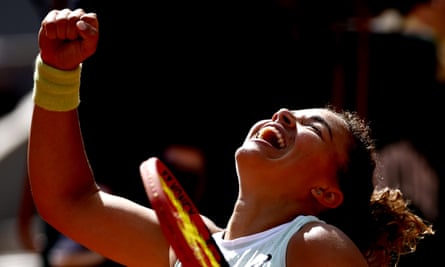From the moment Aryna Sabalenka entered Court Philippe-Chatrier on Wednesday afternoon, it was clear something was off. She immediately looked uncomfortable, bending over between points, holding her stomach and wildly gesticulating to members of her team. Midway through the opening set, the Belarusian called the trainer and began gulping down pills.
A physically compromised opponent is an opportunity, but in tennis it can also be a curse. In her first grand slam quarter-final, Mirra Andreeva was charged with keeping her opponent’s struggles and the significance of the moment out of her head, instead focusing only on playing the next point to the best of her ability.
So far in her young career, Andreeva has already shown she has the temperament and self-belief for big occasions. She did so again on Wednesday, holding her nerve in the tension-filled closing stages to reach her first grand slam semi-final at Roland Garros with a 6-7 (5), 6-4, 6-4 win over Sabalenka, the world No 2.
Having turned 17 at the end of April, Andreeva can only play a limited number of tournaments in a year but she continues to make incredible use of those appearances.
She is now the youngest player to reach a grand slam semi-final since a 16-year-old Martina Hingis in 1997 and she is the youngest player to defeat a top-two player at a slam since Jelena Dokic in 1999. The Russian will rise to a new career high of No 23 in the world rankings, already within touching distance of becoming a top 20 player.
For much of this tournament, the bottom half of the women’s draw seemed like it would inevitably end in a battle between Sabalenka and Elena Rybakina. Instead, the unseeded Andreeva and Jasmine Paolini, the 12th seed, will face each other with a the chance of a first grand slam final on the line for both players.

Earlier on Wednesday, Paolini, who stands at only 1.63 metres (5ft 4in), outmanoeuvred and outplayed the 1.84 metres (6ft) Rybakina, reaching her first major semi-final and breaking the top 10 with a 6-2, 4-6, 6-4 win. With Jannik Sinner’s run to the men’s singles semi-finals, this is the first time in the Open era that Italian players have reached the semi-finals in the men’s and women’s singles draws.
“We tried to not make it a problem,” Paolini said, smiling, of her height. “We try to do something different, to improve other aspects like serve. I wish I was taller, but it’s OK, I’m not. We have to do with what we have.”
after newsletter promotion
With Sabalenka searching for a seventh consecutive grand slam semi-final and showing such consistency in the big events, for much of the match it still seemed like she would find a way through even though she was physically compromised. While she struggled to move freely and her game was caked with errors, when she truly needed to step up, she consistently found a nuclear serve or a thunderous forehand. She powered through an intense opening set, dictating the final points of the tie-break.
Andreeva’s rise is a result of her on-court intelligence, her ability to absorb and redirect her opponent’s pace with ease and the variety she plays with, mixing in drop shots, angles and forays to the net. Most of all, she is intensely competitive.
“Honestly, I kind of see the game,” she said afterwards. “I just play wherever I want. I don’t even really have a plan. When I feel like there’s space on the court, I try to play there. Or if I think that maybe she will run there, I try to play behind here. Me and my coach, we had a plan today, but again, I didn’t remember anything.”
Rather than cowering after the first set, Andreeva responded by taking the ball earlier, exposing Sabalenka’s limited movement and making an already uncomfortable adversary even less at ease.
As the stakes rose throughout the final set, the 17-year-old met a messy, turbulent contest with a few moments of brilliance. She closed out the biggest win of her career by defending from sideline to sideline before slipping a sweet backhand lob over Sabalenka’s head.
Source: theguardian.com


















